The Pinoy Exotic Taste
Philippines is an abstraction—truly, if incredibly, a part unknown.
I gravitate towards the mobility of industrial successes but what fascinates me the most is the surge of interest in all things food-related, coupled with desires for experiential travel. This drives the growing food tourism market.
Food tourism is the pursuit and enjoyment of significant food and drink experiences, near and far. It is inclusive, and encompasses anything from food carts, restaurants, culinary program and tours, to one-of-a-kind plateful.
What’s the next fad food?
Filipinos’ reverence for food is undeniable, and while we still flunk the radar of the mainstream America, I think it’s changing even when everyone else loves Chinese food, Thai food, or Japanese food. Like come on, they’ve all been exploited!
With Filipinos combining the best of that with Spanish technique, it’s going to get to the critical mass and run the vertical front. Perhaps, one of the best U.S. cities to frequent for fine Filipino cuisine is Chicago. Restaurants like Meral’s Kitchen, Isla Filipino and Little Quiapo Restaurant are all located within the city’s borders and feature dishes that exemplify Filipino cooking.
How quickly Filipino food becomes synonymous with Chinese food in terms of its pervasiveness is anyone’s guess, but if it bears any resemblance to the rate at which the Filipino population has increased in the U.S., it could be soon. Aren’t you excited?
The unusual food indulgence
Summer is all about adventure and the invigorating warmth of freedom. While adventures equal to beach escapades, road trips, and flying to the solstice hubs, spending it uniquely adds to the more excitement. It’s time to burgeon the experiences ‘unfamiliar’, prep your travelling genius, and revel in.
What is not more thrilling than delighting your palette with unique food choices, aside from somersaulting 40ft mid-air on a zip line ride? You’re not only able to enjoy and understand a place you pay a visit, but you also get a taste of its character—something that’s worth tale telling.
Focus Weekly sums up a number of bizarre foods you shouldn’t miss braving in this summer. We got ambitious and crammed the country’s culinary trails. Dare yourself to seek out and taste some of the curious fare listed to shock the senses and reinvigorate your palette:
Pampanga – Kamaru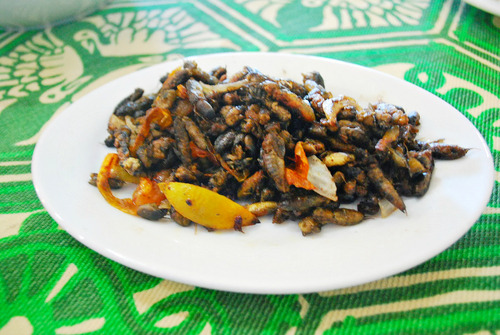 Mostly, the main ingredients in Filipino exotic dishes are insects. One of it is adobong kamaru—probably one of the best culinary traditions in Pampanga. Kamaru is a mole cricket, from the family Gryllotalpidae. This insect is muscular; you can justify by holding one in the hand. Scientifically proven to be edible, they are close to a staple protein source sustaining 28% of the daily nutrient need.
Mostly, the main ingredients in Filipino exotic dishes are insects. One of it is adobong kamaru—probably one of the best culinary traditions in Pampanga. Kamaru is a mole cricket, from the family Gryllotalpidae. This insect is muscular; you can justify by holding one in the hand. Scientifically proven to be edible, they are close to a staple protein source sustaining 28% of the daily nutrient need.
 Mostly, the main ingredients in Filipino exotic dishes are insects. One of it is adobong kamaru—probably one of the best culinary traditions in Pampanga. Kamaru is a mole cricket, from the family Gryllotalpidae. This insect is muscular; you can justify by holding one in the hand. Scientifically proven to be edible, they are close to a staple protein source sustaining 28% of the daily nutrient need.
Mostly, the main ingredients in Filipino exotic dishes are insects. One of it is adobong kamaru—probably one of the best culinary traditions in Pampanga. Kamaru is a mole cricket, from the family Gryllotalpidae. This insect is muscular; you can justify by holding one in the hand. Scientifically proven to be edible, they are close to a staple protein source sustaining 28% of the daily nutrient need.
They go very well with cold beer. They are crispy on the outside, and moist on the inside, making it a favorite pulutan (finger food) for the Kapampangans. Several restaurants in Pampanga serve this dish, including Everybody’s Café in San Fernando.
When preparing, it is recommended to remove the harder outer wings and legs before eating the creepy crawlers.
Pampanga - Betute (stuffed frogs)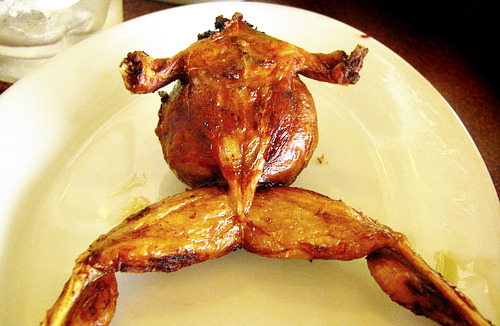

Betute is also one of Kapampangan exotic dishes. Farmers in Pampanga used to depend on rainwater to irrigate their farms. Children would then catch the frogs that came out during the rainy season, while their parents cultivate the lands. Outwitting the frogs has been a traditional “family bonding” ritual. Betute is a play of words on butete, which means “tadpole” in the local dialect. Betute is the entire frog stuffed with minced pork. It is then deep-fried in oil.
Nueva Ecija – Abal- Abal

Abal- Abal, or salagubang is a common treat mostly in the northern part of the Philippines particularly Nueva Ecija, where many of these beetles thrive. These cheeping bugs inhabit agricultural fields and burrow themselves in soil, but also have wings and could fly. They are thick-bodied making them crunchy when toasted or stir-fried. The head is not included when you cook it because the snout is sharp and hard. Salagubang can be legally found in some markets in Nueva Ecija.
Rizal – Uok

Uok is a coconut rhinoceros beetle larva which can be found in dead coconut logs. This fat, eerie worm can be eaten raw but best when cooked adobo style. Adobong uok was featured in Andrew Zimmern’s (chef, food writer, and television personality) show called “Bizarre Foods” in Travel and Living Channel, where he described the taste as glutinous and earthy.
Ilocos – Abuos Itlog ti abuos (fruit-tree ant eggs) is a popular delicacy in the northern parts of Luzon. Often sautéed in garlic and onions, this native dish, which looks a lot like roasted legumes, is a tasty treat that’s also claimed to be an effective aphrodisiac.
Itlog ti abuos (fruit-tree ant eggs) is a popular delicacy in the northern parts of Luzon. Often sautéed in garlic and onions, this native dish, which looks a lot like roasted legumes, is a tasty treat that’s also claimed to be an effective aphrodisiac.
 Itlog ti abuos (fruit-tree ant eggs) is a popular delicacy in the northern parts of Luzon. Often sautéed in garlic and onions, this native dish, which looks a lot like roasted legumes, is a tasty treat that’s also claimed to be an effective aphrodisiac.
Itlog ti abuos (fruit-tree ant eggs) is a popular delicacy in the northern parts of Luzon. Often sautéed in garlic and onions, this native dish, which looks a lot like roasted legumes, is a tasty treat that’s also claimed to be an effective aphrodisiac.
Egg harvesting season is usually done this time of the year extending until June. Gatherers scout dense forests for ants’ nests found clumped in trees by smoking them out so they can easily get the eggs without being stung.
Abuos eggs are a common offering in public markets in the north and because it’s a rare cuisine, like the famous Western dish, caviar, they are sold a tad bit pricy at P200 to P350.
Balut - All over the Philippines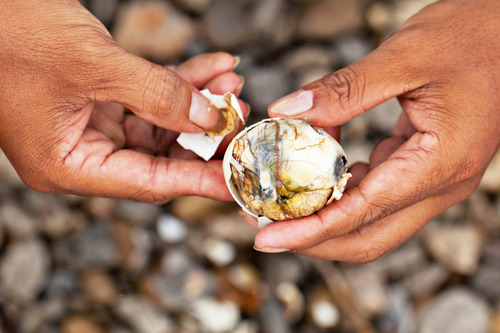 Though considered an object of culinary fascination around the world and common eats among many Filipinos, there are still those who have yet to pluck up the courage to try balut because then, it is no beauty queen. Balut is a fertilized duck egg, either 16 or 18 days old, which has been boiled and is eaten with salt or vinegar, has revolted even the most daring foodies with its carnal textures, earning it lofty rankings on many a “most disgusting/strange/terrifying food” list.
Though considered an object of culinary fascination around the world and common eats among many Filipinos, there are still those who have yet to pluck up the courage to try balut because then, it is no beauty queen. Balut is a fertilized duck egg, either 16 or 18 days old, which has been boiled and is eaten with salt or vinegar, has revolted even the most daring foodies with its carnal textures, earning it lofty rankings on many a “most disgusting/strange/terrifying food” list.
 Though considered an object of culinary fascination around the world and common eats among many Filipinos, there are still those who have yet to pluck up the courage to try balut because then, it is no beauty queen. Balut is a fertilized duck egg, either 16 or 18 days old, which has been boiled and is eaten with salt or vinegar, has revolted even the most daring foodies with its carnal textures, earning it lofty rankings on many a “most disgusting/strange/terrifying food” list.
Though considered an object of culinary fascination around the world and common eats among many Filipinos, there are still those who have yet to pluck up the courage to try balut because then, it is no beauty queen. Balut is a fertilized duck egg, either 16 or 18 days old, which has been boiled and is eaten with salt or vinegar, has revolted even the most daring foodies with its carnal textures, earning it lofty rankings on many a “most disgusting/strange/terrifying food” list.
While food journalists commonly label balut as the Philippines’ “much loved delicacy,” in reality Filipinos are decidedly split over their nation’s oft-sung snack.
Cordillera Region – Etag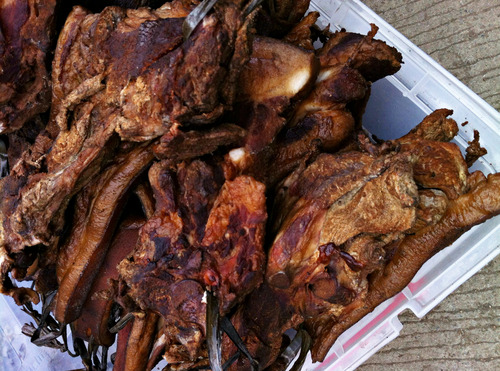 Etag is an Igorot dish that is preserved small slab of meat (esp. pork) made through salt-treating, sun-drying or smoking. is salted pork that is kept underground in earthenware jars to age. It is not a dish in itself, as it is most often used as an ingredient in other viands, but it adds a very distinct flavor to meat or vegetable dishes. Its color is partly dark brown with noticeable whitish yellow fat color.
Etag is an Igorot dish that is preserved small slab of meat (esp. pork) made through salt-treating, sun-drying or smoking. is salted pork that is kept underground in earthenware jars to age. It is not a dish in itself, as it is most often used as an ingredient in other viands, but it adds a very distinct flavor to meat or vegetable dishes. Its color is partly dark brown with noticeable whitish yellow fat color.
 Etag is an Igorot dish that is preserved small slab of meat (esp. pork) made through salt-treating, sun-drying or smoking. is salted pork that is kept underground in earthenware jars to age. It is not a dish in itself, as it is most often used as an ingredient in other viands, but it adds a very distinct flavor to meat or vegetable dishes. Its color is partly dark brown with noticeable whitish yellow fat color.
Etag is an Igorot dish that is preserved small slab of meat (esp. pork) made through salt-treating, sun-drying or smoking. is salted pork that is kept underground in earthenware jars to age. It is not a dish in itself, as it is most often used as an ingredient in other viands, but it adds a very distinct flavor to meat or vegetable dishes. Its color is partly dark brown with noticeable whitish yellow fat color.
Palawan - Kinilaw na tamilok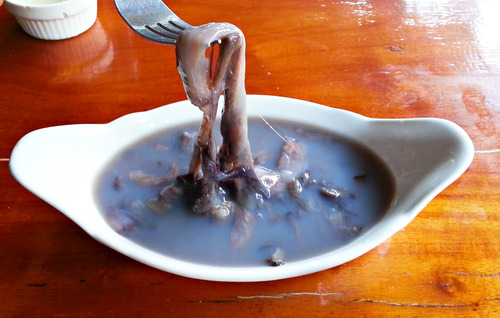 "Tommy, look!" were the words uttered by a foreign visitor when he and his companion chanced upon locals in Palawan eating raw woodworms with vinegar. Since then, the woodworms which usually hide in the crevices of the branches of the mangrove tree, known as bakawan have been called as tamilok.
"Tommy, look!" were the words uttered by a foreign visitor when he and his companion chanced upon locals in Palawan eating raw woodworms with vinegar. Since then, the woodworms which usually hide in the crevices of the branches of the mangrove tree, known as bakawan have been called as tamilok.
 "Tommy, look!" were the words uttered by a foreign visitor when he and his companion chanced upon locals in Palawan eating raw woodworms with vinegar. Since then, the woodworms which usually hide in the crevices of the branches of the mangrove tree, known as bakawan have been called as tamilok.
"Tommy, look!" were the words uttered by a foreign visitor when he and his companion chanced upon locals in Palawan eating raw woodworms with vinegar. Since then, the woodworms which usually hide in the crevices of the branches of the mangrove tree, known as bakawan have been called as tamilok.
Despite its technical name, woodworms aren’t worms at all; they’re mollusks, which is why they tend to have an oyster-like taste and texture. You won’t know until you try it. Mostly served kinilaw-style, the woodworms are soaked in vinegar with chilli peppers, onions, and calamansi juice.
Cordillera Region – Pinikpikan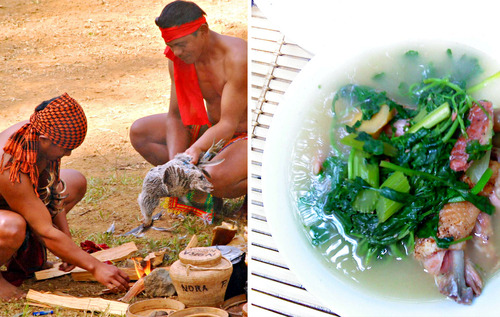 Pinikpikan is a controversial yet famous native dish from the highlands of Cordillera. For some, it is an extreme eating, but looking closely at the end product, it looks pretty simple and plain delicious, near to tinola. The flavors of the dish come from the coagulated blood, the burned feathers and skin, and one special ingredient called Etag, which is a cured and smoked meat, aged and kept underground in earthen jars.
Pinikpikan is a controversial yet famous native dish from the highlands of Cordillera. For some, it is an extreme eating, but looking closely at the end product, it looks pretty simple and plain delicious, near to tinola. The flavors of the dish come from the coagulated blood, the burned feathers and skin, and one special ingredient called Etag, which is a cured and smoked meat, aged and kept underground in earthen jars.
 Pinikpikan is a controversial yet famous native dish from the highlands of Cordillera. For some, it is an extreme eating, but looking closely at the end product, it looks pretty simple and plain delicious, near to tinola. The flavors of the dish come from the coagulated blood, the burned feathers and skin, and one special ingredient called Etag, which is a cured and smoked meat, aged and kept underground in earthen jars.
Pinikpikan is a controversial yet famous native dish from the highlands of Cordillera. For some, it is an extreme eating, but looking closely at the end product, it looks pretty simple and plain delicious, near to tinola. The flavors of the dish come from the coagulated blood, the burned feathers and skin, and one special ingredient called Etag, which is a cured and smoked meat, aged and kept underground in earthen jars.
What makes Pinikpikan debated is how the chicken is slaughtered. The preparation involves a live chicken punctured with sticks before cooking. It is a ritual performed by the Cordillera tribes to decide their fate. It takes hours of careful work to prepare an authentic Pinikpikan. The chicken is then battered to keep the blood inside. Also, none of the bones should be disjointed during the process of beating or even when slicing.
Manila and Cebu - Soup No. 5 or Lanciao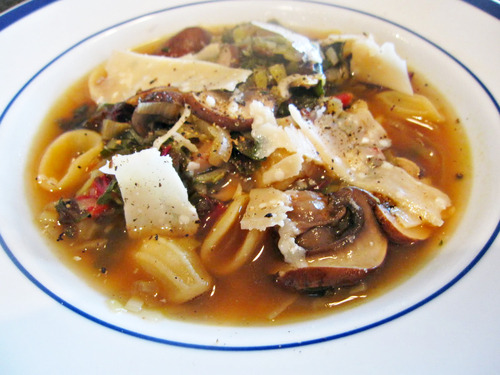

This exotic dish is not for the faint of heart. But sneer at it all you want, it has been cited by an international travel guide as among the notable features of Manila’s Chinatown.
Soup No. 5 looks like a regular meat soup but is actually made of bull or ox penis and testicles. The dish which probably originated from the creative Filipino roadside eateries is believed to have potent aphrodisiac properties, thus becoming one of the most challenging spurs among the bravest foodies especially the males. Particularly for those who prefer the natural ways of attaining sexual enthusiasm than with the help of tablets produced by medical science.
Some restaurants in Binondo serve this dish, and it can also be found in Cebu, where it is known as Lanciao.

